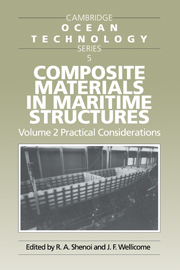Book contents
- Frontmatter
- Contents
- Preface
- List of Authors
- 1 Introduction
- 2 Design of Displacement Craft
- 3 Design of Dynamically Supported Craft
- 4 The Role of Adhesives
- 5 Practical Design of Joints and Attachments
- 6 Production of Ships with Single Skin Structures
- 7 Production of Yacht Hulls of Sandwich Configuration
- 8 Material Case Study - Failures and their Repairs
- 9 Response of Sandwich Structures to Slamming and Impact Loads
- 10 Fatigue Characteristics
- 11 Composites in Offshore Structures
- 12 Regulatory Aspects in Design
- 13 Quality and Safety Assessment
- 14 Design Management and Organisation
- Appendix
- Index
2 - Design of Displacement Craft
Published online by Cambridge University Press: 04 August 2010
- Frontmatter
- Contents
- Preface
- List of Authors
- 1 Introduction
- 2 Design of Displacement Craft
- 3 Design of Dynamically Supported Craft
- 4 The Role of Adhesives
- 5 Practical Design of Joints and Attachments
- 6 Production of Ships with Single Skin Structures
- 7 Production of Yacht Hulls of Sandwich Configuration
- 8 Material Case Study - Failures and their Repairs
- 9 Response of Sandwich Structures to Slamming and Impact Loads
- 10 Fatigue Characteristics
- 11 Composites in Offshore Structures
- 12 Regulatory Aspects in Design
- 13 Quality and Safety Assessment
- 14 Design Management and Organisation
- Appendix
- Index
Summary
INTRODUCTION
Background
This Chapter considers the use of composite materials for the construction of displacement vessels such as mine countermeasures vessels (MCMVs). These are currently the largest ships afloat built entirely of fibre reinforced plastics (FRP). In the UK alone there are 19 FRP construction MCMVs of three successive classes, either at sea or under construction. The largest FRP ships are the USA Osprey Class MHC, having an overall length of 63 metres and a deep displacement of 850 tonnes.
A variety of structural ‘styles’ are used, including stiffened single skin, sandwich, frameless monocoque or a combination of all three. Corrugated construction has been suggested as a possible structural style for future generations of MCMVs.
Why Composite Materials?
GFRP composite materials have been the clear choice for the construction of MCMVs of 45-60 metres in length for the last 25 years, largely because of characteristics other than their mechanical properties, and have in fact replaced wood almost completely. For MCMVs composites offer the following advantages over steel and wood, enabling the exacting design requirements of these specialised ships to be met:
- Non-conducting
- Non-magnetic
- More economical to build and repair than wood
- Better ruggedness and explosion resistance than wood
- Does not rot or corrode in a marine environment.
In considering the use of FRP for the construction of other, perhaps more conventional types of ships, mild steel remains the most obvious choice. One of the main advantages offered by composite materials over steel is weight-saving. However, although weight-saving in any type of marine structure is an advantage, it is least critical in the case of displacement vessels.
- Type
- Chapter
- Information
- Composite Materials in Maritime Structures , pp. 3 - 25Publisher: Cambridge University PressPrint publication year: 1993
- 1
- Cited by

